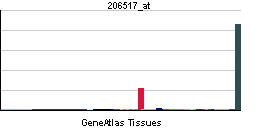CDH16
| Cadherin 16, KSP-cadherin | |||||||||||
|---|---|---|---|---|---|---|---|---|---|---|---|
| Identifiers | |||||||||||
| Symbols | CDH16 ; | ||||||||||
| External IDs | Template:OMIM5 Template:MGI HomoloGene: 2997 | ||||||||||
| |||||||||||
| RNA expression pattern | |||||||||||
 | |||||||||||
| More reference expression data | |||||||||||
| Orthologs | |||||||||||
| Template:GNF Ortholog box | |||||||||||
| Species | Human | Mouse | |||||||||
| Entrez | n/a | n/a | |||||||||
| Ensembl | n/a | n/a | |||||||||
| UniProt | n/a | n/a | |||||||||
| RefSeq (mRNA) | n/a | n/a | |||||||||
| RefSeq (protein) | n/a | n/a | |||||||||
| Location (UCSC) | n/a | n/a | |||||||||
| PubMed search | n/a | n/a | |||||||||
Cadherin 16, KSP-cadherin, also known as CDH16, is a human gene.[1]
This gene is a member of the cadherin superfamily, genes encoding calcium-dependent, membrane-associated glycoproteins. Mapped to a previously identified cluster of cadherin genes on chromosome 16q22.1, the gene localizes with superfamily members CDH1, CDH3, CDH5, CDH8 and CDH11. The protein consists of an extracellular domain containing 6 cadherin domains, a transmembrane region and a truncated cytoplasmic domain but lacks the prosequence and tripeptide HAV adhesion recognition sequence typical of most classical cadherins. Expression is exclusively in kidney, where the protein functions as the principal mediator of homotypic cellular recognition, playing a role in the morphogenic direction of tissue development.[1]
References
Further reading
- Thomson RB, Igarashi P, Biemesderfer D; et al. (1995). "Isolation and cDNA cloning of Ksp-cadherin, a novel kidney-specific member of the cadherin multigene family". J. Biol. Chem. 270 (29): 17594–601. PMID 7615566.
- Maruyama K, Sugano S (1994). "Oligo-capping: a simple method to replace the cap structure of eukaryotic mRNAs with oligoribonucleotides". Gene. 138 (1–2): 171–4. PMID 8125298.
- Suzuki Y, Yoshitomo-Nakagawa K, Maruyama K; et al. (1997). "Construction and characterization of a full length-enriched and a 5'-end-enriched cDNA library". Gene. 200 (1–2): 149–56. PMID 9373149.
- Thomson RB, Ward DC, Quaggin SE; et al. (1998). "cDNA cloning and chromosomal localization of the human and mouse isoforms of Ksp-cadherin". Genomics. 51 (3): 445–51. doi:10.1006/geno.1998.5402. PMID 9721215.
- Thomson RB, Aronson PS (1999). "Immunolocalization of Ksp-cadherin in the adult and developing rabbit kidney". Am. J. Physiol. 277 (1 Pt 2): F146–56. PMID 10409308.
- Baudry D, Jeanpierre C (2000). "Assignment of E-cadherin (CDH1) and KSP-cadherin (CDH16) to chromosome 16q22.1 by radiation hybrid mapping". Cytogenet. Cell Genet. 88 (3–4): 253–4. PMID 10828602.
- Strausberg RL, Feingold EA, Grouse LH; et al. (2003). "Generation and initial analysis of more than 15,000 full-length human and mouse cDNA sequences". Proc. Natl. Acad. Sci. U.S.A. 99 (26): 16899–903. doi:10.1073/pnas.242603899. PMID 12477932.
- Thomson RB, Mentone S, Kim R; et al. (2003). "Histopathological analysis of renal cystic epithelia in the Pkd2WS25/- mouse model of ADPKD". Am. J. Physiol. Renal Physiol. 285 (5): F870–80. doi:10.1152/ajprenal.00153.2003. PMID 12851251.
- Clark HF, Gurney AL, Abaya E; et al. (2003). "The secreted protein discovery initiative (SPDI), a large-scale effort to identify novel human secreted and transmembrane proteins: a bioinformatics assessment". Genome Res. 13 (10): 2265–70. doi:10.1101/gr.1293003. PMID 12975309.
- Wendeler MW, Praus M, Jung R; et al. (2004). "Ksp-cadherin is a functional cell-cell adhesion molecule related to LI-cadherin". Exp. Cell Res. 294 (2): 345–55. doi:10.1016/j.yexcr.2003.11.022. PMID 15023525.
- Gerhard DS, Wagner L, Feingold EA; et al. (2004). "The status, quality, and expansion of the NIH full-length cDNA project: the Mammalian Gene Collection (MGC)". Genome Res. 14 (10B): 2121–7. doi:10.1101/gr.2596504. PMID 15489334.
- Hishikawa K, Marumo T, Miura S; et al. (2005). "Leukemia inhibitory factor induces multi-lineage differentiation of adult stem-like cells in kidney via kidney-specific cadherin 16". Biochem. Biophys. Res. Commun. 328 (1): 288–91. doi:10.1016/j.bbrc.2004.12.167. PMID 15670782.
- Thedieck C, Kuczyk M, Klingel K; et al. (2005). "Expression of Ksp-cadherin during kidney development and in renal cell carcinoma". Br. J. Cancer. 92 (11): 2010–7. doi:10.1038/sj.bjc.6602597. PMID 15886705.
- Kuehn A, Paner GP, Skinnider BF; et al. (2007). "Expression analysis of kidney-specific cadherin in a wide spectrum of traditional and newly recognized renal epithelial neoplasms: diagnostic and histogenetic implications". Am. J. Surg. Pathol. 31 (10): 1528–33. doi:10.1097/PAS.0b013e318058818c. PMID 17895753.
| This protein-related article is a stub. You can help Wikipedia by expanding it. |